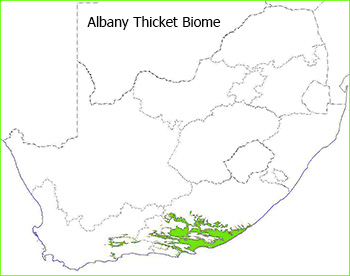The following is an extract of text from Low & Rebelo (1996) for Thicket Biome. They considered Strandveld (included in Fynbos Biome in Mucina and Rutherford (2006)) as part of the Thicket Biome.

Synonyms:. Subtropical Thicket, Subtropical Transitional Thicket
There is no formal "Thicket Biome" recognized in the scientific literature. However, we felt that the vegetation which replaces forest - where a degree of fire protection is still evident, but rainfall is too low - did not fit within the "Forest" type as it does not have the required height nor the many strata below the canopy. Nor is it a "Savanna" type, in that it does not have a conspicuous grassy ground layer.
Subtropical thicket is a closed shrubland to low forest dominated by evergreen, sclerophyllous or succulent trees, shrubs and vines, many of which have stem spines. It is often almost impenetrable, is generally not divided into strata, and has little herbaceous cover. Because the vegetation types within the "Thicket Biome" share floristic components with many other phytochoria and lie within almost all the formal biomes, Thicket types have been referred to as "transitional thicket". Thicket types contain few endemics, most of which are succulents of Karoo origin(e.g. plakkies Crassula spp. and sheep fig Delosperma spp.). A complete list of characteristic species of subtropical thicket and subdivisions into different types can be found in Everard (1987).
In this overview, five vegetation types are recognized on the basis of their distribution and the degree of succulence in the shrub and tree species.
Click images to enlarge







